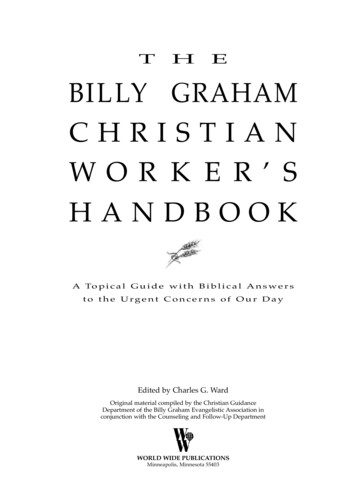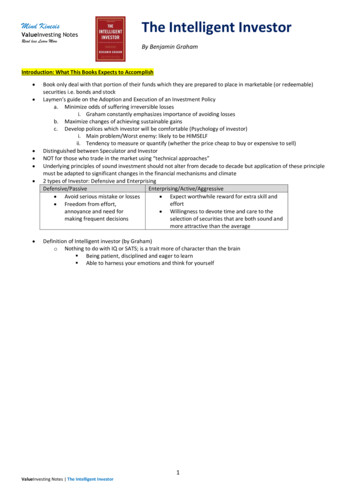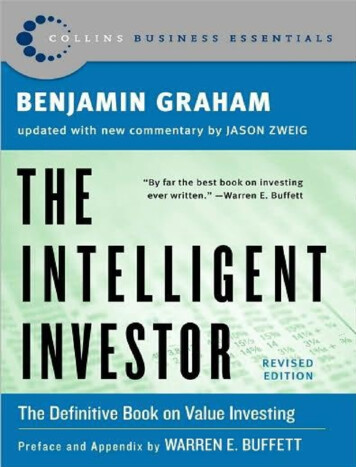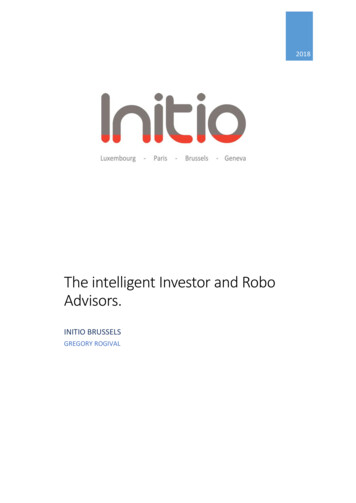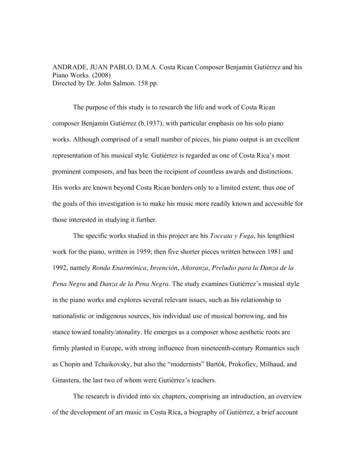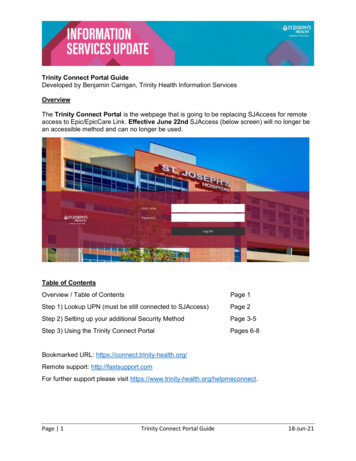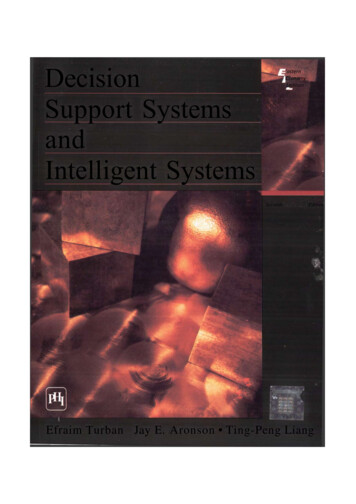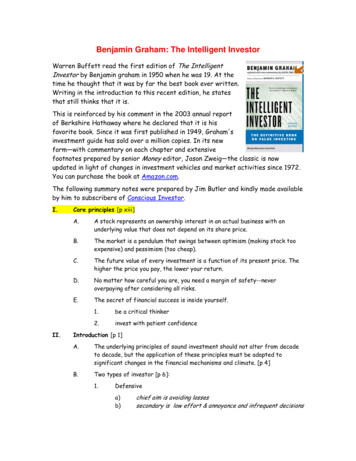
Transcription
Benjamin Graham: The Intelligent InvestorWarren Buffett read the first edition of The IntelligentInvestor by Benjamin graham in 1950 when he was 19. At thetime he thought that it was by far the best book ever written.Writing in the introduction to this recent edition, he statesthat still thinks that it is.This is reinforced by his comment in the 2003 annual reportof Berkshire Hathaway where he declared that it is hisfavorite book. Since it was first published in 1949, Graham'sinvestment guide has sold over a million copies. In its newform—with commentary on each chapter and extensivefootnotes prepared by senior Money editor, Jason Zweig—the classic is nowupdated in light of changes in investment vehicles and market activities since 1972.You can purchase the book at Amazon.com.The following summary notes were prepared by Jim Butler and kindly made availableby him to subscribers of Conscious Investor.I.II.Core principles [p xiii]A.A stock represents an ownership interest in an actual business with anunderlying value that does not depend on its share price.B.The market is a pendulum that swings between optimism (making stock tooexpensive) and pessimism (too cheap).C.The future value of every investment is a function of its present price. Thehigher the price you pay, the lower your return.D.No matter how careful you are, you need a margin of safety--neveroverpaying after considering all risks.E.The secret of financial success is inside yourself.1.be a critical thinker2.invest with patient confidenceIntroduction [p 1]A.The underlying principles of sound investment should not alter from decadeto decade, but the application of these principles must be adapted tosignificant changes in the financial mechanisms and climate. [p 4]B.Two types of investor [p 6]:1.Defensivea)b)chief aim is avoiding lossessecondary is low effort & annoyance and infrequent decisions
Summary Notes for The Intelligent Investor2.Enterprising (active or aggressive)a)b)C.seeking a slightly better return (because expectingsignificantly better returns is probably unrealistic)MYTH of promising industries [p 6-8]1.Concept: locate the industries that are most promising, and then pickbest companies in those industries2.computers and IBM are examples3.airlines and computers both show the fallacy of this approacha)b)c)III.determining trait is willingness to devote time and care toselection of securitiesobvious prospects for physical growth in a business do nottranslate into obvious profits for investorsexperts do not have dependable ways to select the mostpromising companies in the most promising industries [Thismay not consider the consistent history of profits, ROI,growth, etc. reflected in John Price's STAEGR concept.]By the time that everyone has decided on the best company,the prices have been bid so high that future returns have noupside. [p 16-17]D.Value investing -- Graham says that "For 99 issues out of 100 we could saythat at some price they are cheap enough to buy and at some other pricethey would be so dear that they should be sold." p 8]E.Stocks become riskier as the prices rise, not less. Stocks become less riskyas their prices fall. [p 17]F.The bear market is good news with buying opportunities.G.Stock market predictions of brokerage firms are somewhat less reliablethan flipping a coin. [p 10]H.Isaac Newton, the timing expert [p 13-14]1.In 1720, he bought stock in the South Sea Company, which was thenthe hottest stock in England.2.He sold it for a 7,000 pound profit (almost 1 million in today'smoney), saying that he "could calculate the motions of the heavenlybodies, but not the madness of the people." (referring to the marketfrenzy).3.Several months later as wild enthusiasm carried the stock higher,Newton jumped back in but at a much higher price, and then lostmore than 20,000 pounds ( 3 million in today's money).Investment vs. Speculation [p 18]A."An investment operation is one which, upon thorough analysis, promisesPrepared by Jim Butlerwww.consciousinvestor.com2 / 21
Summary Notes for The Intelligent Investorsafety of principal and adequate return. Operations not meeting theserequirements are speculative." [ p 18]B.C.D.Note the components of investing [p 35]:1.thoroughly analyze a company and the underlying business2.deliberately protect yourself against serious losses3.aspire to "adequate" and not extraordinary, performance.Everyone who buys the so-called "hot" common stock issues is eitherspeculating or gambling. [p 21]1.An investor calculates what a stock is worth based on the value ofthe underlying business. [p 36]2.A speculator gambles that a stock will go up in price becausesomebody else will pay even more for it. [p 36]The portfolio [p 22-23]1.Bonds should never be less than 25% of the portfolio nor more than75% of it.2.Simplest solution for the Defensive Investor is 50-50 commonstocks and bonds.3.Adjust portfolioa)b)IV.whenever shifts of 5% or moreat regular intervals (i.e. 6 months) -- suggestion of JasonZweig4.Alternative approach is to reduce common stock percentage to 25%when common stocks seem very speculatively high, or to increasestock percentage to 75% when common stocks seem very low.5."The future of security prices is never predictable." [p 24]6.The Defensive Investor must confine himself to the shares ofimportant companies with a long record of profitable operations andin strong financial condition." [p 28]7.If you look at a large quantity of data long enough, a huge number ofpatterns will emerge, if only by chance. [p 45]8.Stocks do well or poorly in the future because the businesses behindthem do well or poorly--nothing more, and nothing less. [p 45]9.For most of us, 10% of our overall wealth is the maximum permissibleamount to put at speculative risk. [p 46]The Investor and Inflation [p 47]A.There is no close time connection between inflationary (or deflationary)conditions and the movement of common stock earnings and prices. [p 51]Prepared by Jim Butlerwww.consciousinvestor.com3 / 21
Summary Notes for The Intelligent InvestorB.V.Study of earnings rate on capital shown by American Business [p 51-52]:1.No general tendency to advance with wholesale prices or cost ofliving.2.Conclusion: the investor cannot count on much above the recent 5year rate earned on the DJIA group.3.Cold figures demonstrate that ALL large gains in earnings of theDJIA in the past 20 years was due to a proportional large growth ofinvested capital coming from reinvested profits. [p 52]4."The only way that inflation can add to common stock values is byraising the rate of earnings on capital investment. On the basis ofthe past record this has not been the case." [p 52]C.Conclusion: An investor has no sound basis for expecting more than anaverage overall return of, say, 8% on a portfolio of DJIA-type commonstocks purchased at the late 1971 price level.If there is one thingguaranteed for the future, it is that the earnings and average annual marketvalue of a stock portfolio will not grow at the uniform rate of 4%, or anyother figure. In the memorable words of the elder J.P. Morgan, "They willfluctuate." [p 54]D.It took 25 years for GE and the DJIA itself to recover the ground lost inthe 1929-1932 debacle. [p 55]E.Investor cannot afford to put all his funds into one basket--neither thebond basket, despite unprecedented high returns that bonds offer, nor inthe stock basket, despite the prospect of continuing inflation. [p 56]F.Stocks are not a guarantee against inflation. The stock market lost money in8 of the past 14 years in which inflation exceeded 6% per year. The averagereturn for those 14 years was only 2.6%. Stocks have failed to keep up withinflation about 1/5 of the time. [p 61]A Century of Stock Market History [p 65]A.The investor must never forecast the future exclusively by extrapolatingthe past.1.This includes the corollaries such as forecasters who argue thatstocks have returned an annual average of 7% after inflation eversince 1802. Therefore, investors should expect the same in thefuture. [p 80]2.The value of any investment is and always must be a function of theprice you pay for it. [p 83]3.Robert Shiller, a finance professor at Yale, was inspired by Graham'svaluation approach. he studies historical records and found [p 85-86]a)Prepared by Jim Butlerwhen the PE ratio goes well above 20, the market usuallywww.consciousinvestor.com4 / 21
Summary Notes for The Intelligent Investorb)c)VI.VII.delivers poor returns afterwardwhen the PE ratio drops well below 10, stocks typicallyproduce handsome gains down the road.see chart of total return for next 10 years when PEs wentover 20 [p 86].General Portfolio Policy: The Defensive Investor [p 88]A.Reminder: The defensive investor is one who does not want much risk anddoes not want to work very hard, make a lot of decisions, etc.B.Minimum 25% bonds, maximum 75% stocks . and minimum 25% stocks and75% bonds.C.Once you set your proportions, change them only as your circumstanceschange.D.Zweig suggest re-balancing to your set proportions every 6 months and topick dates that are easy to remember like New Years and July 4th. [p 105]E.Bond funds bring easy diversification.Defensive Investor and Common Stocks [p 112]A.The argument for common stocks--they offer1.a considerable degree of protection against inflation (bonds, at leastbefore TIPS, offer none).2.higher average return to investors over the years (combination ofdividend yield and appreciation in value).B.These two benefits of common stock investments are lost if too high a priceis paid. [p 113]C.Rules for common stock investment [p 114]:D.1.There should be adequate but not excessive diversification.(minimum of 10, maximum of 30 different issues).2.Each company should be large, prominent and conservativelyfinanced.3.Each company should have a long record of continuous dividendpayments. [Zweig suggests 10 years continuous payments, or maybeeven 20.]4.Investor should limit the price paid to not more than 25 timesaverage earnings for the past 7 years and not more than 20 timesthe last 12 month period.These rules would eliminate many of the most important growth stocks.1.Growth stock is one that has increased its per share earnings in thepast at a rate well over that for common stocks generally and whichis expected to continue to do so in the future.Prepared by Jim Butlerwww.consciousinvestor.com5 / 21
Summary Notes for The Intelligent Investor2.Some authorities say that a growth stock is one that is expected todouble it earnings in 10 years. Using the Rule of 72, this means, it willtake a 7.1% compounded annual growth rate to double earnings in 10.1years . [Rule of 72 tells you how long to double something if youdivide the expected rate of return into 72. So, in this example, 72 /7.1 10.1 years.3.The problem is that on many growth stocks, the prices advancedmany times faster than the rate of growth in earnings.4.Graham says that "we regard growth stocks as a whole as toouncertain and risky a vehicle for the defensive investor . Incontrast we think that the group of large companies that arerelatively unpopular and therefore obtainable at reasonable earningsmultipliers, offers a second if unspectacular area of choice by thegeneral public."5.Note on the Category of "Large, Prominent and ConservativelyFinanced Corporations" [p 122-123]a)b)Finances are not conservative unless book value is at leasthalf of the total capitalization, including bank debtLarge and prominent relate to size and leading position(1)(2)E.Commentarylarge means at least 50 million [Zweig says thattoday that means at least 10 billion]prominent means that the company should be in top1/4 or 1/3 of its industry by size1.Decision about investing in common stocks has nothing to do with howmuch you might have lost in the past. When stocks are pricedreasonably enough to give you future growth, then you should ownthem, regardless of the losses that you have had before. [p 124]2.Peter Lynch says "buy what you know."a)b)c)amateur investors can get important information this way -personal insight into what is workingbut this is ONLY the FIRST STEP!then you have to do the financial analysisstudy the financial statementsotherwise, the "invest in what you know" approach isdangerous(3)causes over confidence -- familiarity breedscomplacencyVIII. Portfolio Policy for the Enterprising Investor: Negative Approach (i.e. theDon'ts) [p 133]A.(1)(2)The aggressive investor starts from the same base as the defensive investorPrepared by Jim Butlerwww.consciousinvestor.com6 / 21
Summary Notes for The Intelligent Investor1.B.C.IX.division of funds between high grade bonds and common stocksbought at reasonable pricesJunk bonds [ p 145-147]1.Graham gave them a big thumbs down.2.Today however there funds that offer diversification thatconcerned Graham, and have much lower cost.3.However most junk bond funds have higher costs and do not do agood job of preserving principal.The more you trade, the less you keep. [p 149]Portfolio Policy for the Enterprising Investor: The Positive Side (i.e. the Dos)[p 155]A.B.The Enterprising Investor does all the work he does to obtain a slightlybetter investment result1.Many would think that you just buy when the market is down and sellwhen it is up. But thorough analysis shows that attempts to do thisjust don't work.2.The best way for dealing with ups and downs in the market isthrough allocation of stock and bond investment proportions. Thegeneral allocation suggested for defensive investor applies here [p156]a)b)c)Growth Stock50-50 is best for mostwide leeway to go 75/25 or 25/75rebalanceapproach [p 157]1.Every investor would like to select the stocks of companies that willdo better than the average over a period of years.2.A growth stock may be defined as one that has done this in the pastand is expected to do so in the future.3.It is just a statistical chore to identify companies that haveoutperformed the averages in the past.4.There are 2 problems with just
Summary Notes for The Intelligent Investor 2. Some authorities say that a growth stock is one that is expected to double it earnings in 10 years. Using the Rule of 72, this means, it will take a 7.1% compounded annual growth rate to double earnings in 10.1 years . [Rule of 72 tells you how long to double something if you divide the expected rate of return into 72. So, in this example, 72 / 7.1 .

